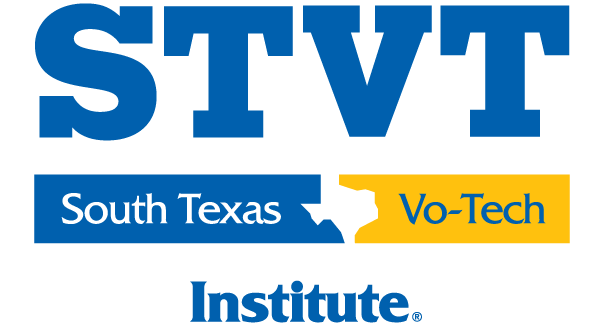Combination Welding Program
Create Your New Future
Welding Training Program Details
South Texas Vocational Technical Institute’s Combination Welding program helps prepare you to pursue a career in construction and maintenance. The Welding program provides instruction on the skills to be a member of the team. Our Combination Welding program emphasizes hands-on learning and workplace safety. STVT is proud to offer a Welder Training Program in South Texas. Our Welding program is available at our San Antonio, Corpus Christi, and Weslaco campuses.
Diploma: 56.5 Credit Hours, 10 Months.
*STVT cannot guarantee job placement, salary or employment
*STVT does not guarantee third-party certifications. Certification requirements for taking and passing certification examinations are not controlled by STVT but by outside agencies and are subject to change by the agencies without notice to STVT. Therefore, STVT cannot guarantee that graduates will be eligible to take certification examinations, regardless of their eligibility status upon enrollment.
What’s Covered
Along with classroom education, students at STVT will get the opportunity to participate in hands-on training to strengthen their skills.

What is NCCER?
Why is NCCER important to you?
Earning NCCER’s industry-recognized credentials means you, having undergone approved training, and have met the standards set by the NCCER. Your universally recognized credentials in your craft represent a national portability of your skills.
Additionally, NCCER manages credentialing and certification through its Registry System, which assists craft trainees and professionals by maintaining their records in a secure database.
NCCER also drives multiple initiatives to enhance career development and recruitment efforts for the industry, primarily through its Build Your Future initiative.
Why is NCCER important to employers?
Many organizations and companies track the qualifications of their craft professionals and possible new hires through NCCER’s Registry System. Those with NCCER credentials may be more desirable to potential employers.
Find This Program At This Campus:
What can you do with a Combination Welding diploma?
After successfully completing our Combination Welding program, graduates may pursue entry-level careers in welding such as:
- Welders
- Tacker Welders
- Welder Helpers
- Fitter Welders
- Welder/Fabricator
According to the Bureau of Labor Statistics (BLS), job growth for Welders is projected to remain steady from 2022 to 2032. They also report the average annual salary for Combination Welders across the nation in 2023 is $48,940. For more specifics on the average annual salary of Combination Welders by state, check out the BLS’ 2023 Occupational Employment and Wages report.
*South Texas Vocational Technical Institute cannot guarantee employment or salary.
Frequently Asked Questions
Combination welders switch between welding processes to complete a wide range of projects. Some techniques combo welders use include:
- flux-cored arc welding (FCAW)
- gas metal arc welding (GMAW)
- gas tungsten arc welding (GTAW)
- shielded metal arc welding (SMAW)
Learning combination welding can prepare you for careers in industries like construction, manufacturing, automotive, and more. It paves the way for hands-on careers, flexible opportunities, and a sense of pride in your work.
At South Texas Vocational Technical Institute, students can learn different welding types and American Welding Society (AWS) standards in as little as 10 months with our Combination Welding program.
When you choose STVT for your combination welding training, you’re choosing hands-on training under the guidance of industry-experienced instructors. As you immerse yourself in our simulation labs, you can put your new skills to the test and receive feedback on your technique.
Our day, evening, and weekend classes allow our program to work around your schedule. We aim to keep our class sizes small to give our students the attention they deserve from our instructors.
We can’t wait to see how your confidence improves as you tackle new projects, master new skills, and move closer to your goals.
While salary varies by location and experience, the Bureau of Labor Statistics (BLS) projects the average salary* of welders in Texas is $53,410 while the Texas Workforce Commission reports it as $63,400.
*South Texas Vocational Technical Institute cannot guarantee salary or employment.
The Texas Workforce Commission projects welding careers to grow by 25.1% between 2020-2030. If this projection holds, over 2,600 welding positions will become available.
There are many paths you can take to become a welder. We cover some possible avenues in our latest blog post What Does a Combo Welder Do and How to Become One.
Ready To Enroll?
Start at STVT to begin the skills-based career training you’ve been dreaming of. Our flexible scheduling and affordable options make it a great place for you to pursue your diploma in Combination Welding. Talk to an admissions representative today.
